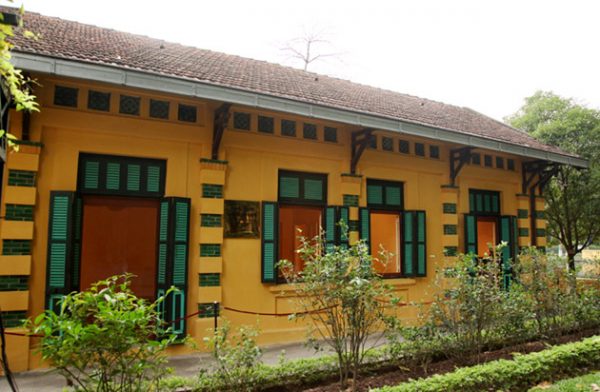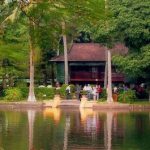With its exceptional historical, cultural, and scientific values, on August 12, 2009, Ho Chi Minh Presidential Palace Historical Site was recognized by the Prime Minister as a special national relic site (under the Prime Minister’s Decision No. 1272/QD-TTg).

Ho Chi Minh Presidential Palace Historical Site is located in Ngoc Ha Ward, Ba Dinh District, Hanoi City. This is the place where President Ho Chi Minh lived and worked for the longest time in his revolutionary life (from December 19, 1954 to September 2, 1969). The place also served as the headquarters of the Central Party Committee and the government of Vietnam after the success of the August Revolution (1945).
The site covers a total area of over 10 hectares with a system of houses, yards, gardens, lawns, fishponds, and roads, the three most prominent relic items of which are House 54, Uncle Ho’s Stilt House, and House 67.
President Ho Chi Minh lived and worked at House 54 for nearly four years (from December 1954 to mid-May 1958). Later on, he moved to the Stilt House that had been built in the Presidential Garden, but still came to House 54 for daily meals and periodic health checks. Thus, House 54 remains a place closely linked with the daily life of President Ho Chi Minh during the last 15 years of his life.
House 54 has three rooms. The room nearest to the pond was the working room and also the place where he welcomed guests. The room in the middle was the dining room, followed by the bedroom.
A set of tableware used daily by him was displayed at President Ho Chi Minh’s dining room. Living supplies in his bedroom were as simple as any ordinary person’s: a set of table and chair for nightly reading, a simple small bed, and a wardrobe containing only a few sets of daily clothes and a set of khaki clothes used for meetings with guests or business trips.
The total number of objects in House 54 is nearly 400 units, 300 of which are paper items. This fact is the realest, most impressive, and most touching evidence of a very pure, simple, yet neat, and tidy lifestyle of President Ho Chi Minh.

Uncle Ho’s Stilt House was where he lived and worked in the summer, also where he met and worked with members of the Politburo, officials in charge of ministries and sectors, local authorities, and especially with the Southern officers and soldiers who had been sent to the North for medical treatment and work.
The upper floor of the Stilt House has a working room and a bedroom. The working room has a table, a chair, and a bookshelf. The bottom shelf of the bookshelf contains the typewriter that was used daily by President Ho Chi Minh.
Living facilities in his bedroom are also very simple. The room has only a rush-mat-covered wooden bed with an addition of a mattress, a blanket, and a small electric heater during winters.
On the desk in his bedroom, there are some books, magazines, a pith helmet, and a transistor radio given to him by overseas Vietnamese in Thailand. There is a desktop clock on the bedside table along with a book titled The thirteenth century resistance war against the Yuan – Mongol invaders that he was reading.
President Ho Chi Minh lived and worked in this house for the last 11 years of his life (1958 – 1969).
At present, almost 250 documents of Uncle Ho and the entire structure and precinct of the Stilt House are preserved at the same state as during his last days of living and working there.
House 67 is located behind the Stilt House (about 30 meters from the House). The construction started on May 1, 1967 and the house was inaugurated on July 20, 1967. This is where President Ho Chi Minh held meetings with the Politburo, the place he worked at during the period of Imperial America’s escalation to the North of Vietnam (1967 – 1969), also where he received medical treatment and passed away, often called House 67 or DK2.
In 1967, Imperial America’s air and naval war expansion against the North became increasingly fierce. Hanoi, Hai Phong, and several other cities and enterprises were bombarded day and night. Facing that situation, the Politburo had decided to build behind the Stilt House a solid house with an air defense basement to the right to ensure absolute safety for President Ho Chi Minh in case of unexpected bombardment. Members of the Department of Construction under the High Command of Engineering had been assigned to design and build the house. The house was completed with walls of over 60 cm thick and ceilings of over 1 meter thick, all made of reinforced concrete.
President Ho Chi Minh did not consider the house to be his only. He suggested using the house for meetings with the Politburo and discussing the country’s important issues with central officials. From August 25, 1969, President Ho Chi Minh started falling ill and developing an increasingly bad and complex condition. As decided by the Politburo, House 67 became the place for his treatment. Members of the Politburo and leading professors and doctors from all over the country gathered to this place to take care of his health. Due to his high age, President Ho Chi Minh could not overcome the critical illness. The clock on the small bedside table and the wall calendar were stopped at the moment he left: 9:47 a.m. on September 2, 1969.
In the past fifty years, nearly 100 documents and objects in the house have been preserved and arranged at the same state as when he was still alive, recalling the activities and matters which President Ho Chi Minh were interested in during his last days.
It could be said that Ho Chi Minh Presidential Palace Historical Site is one of the relic sites of exceptional value in various aspects.
This was the place where President Ho Chi Minh lived in the last fifteen years of his life, also where he, together with the Politburo of the Central Party Committee and the Government, set out the right strategy and tactics for the Vietnamese revolution and led the people to overcome the harsh ordeal to both carry out the two strategic tasks: building socialism in the North and fighting Imperial American and its lackeys to liberate the South and unify the country, actively contributing to the struggle for national independence, democracy, peace, and social progress all around the world.
The relic site was also the place where President Ho Chi Minh organized the reception of international delegations and met with representative Vietnamese people. The relic site, with its efforts to preserve the original states of Uncle Ho’s living and working places, is a site that holds a very specific and emotionally moving and spiritual image of a leader who wholeheartedly devoted himself to the country, but also a leader who had a very simple and pure lifestyle.
With all of its significance, the relic site of President Ho Chi Minh’s living and working places along with its relic items and remembrances have become invaluable exhibits and sacred symbols of his life during his last 15 years, reflecting the highest qualities of Ho Chi Minh’s thought and morality.
Bao Tran (Compiler)

